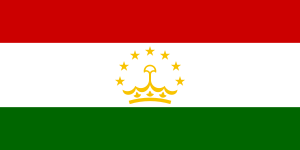Flag of Tajikistan facts for kids

The flag of Tajikistan is the official national flag of the country Tajikistan. It was created in November 1992. This new flag replaced the older flag of the Tajik Soviet Socialist Republic, which had been used since 1953.
Contents
What the Flag Looks Like
The flag of Tajikistan has three horizontal stripes of different colors. These colors are red, white, and green. The red stripe is at the top, the white stripe is in the middle, and the green stripe is at the bottom.
The middle white stripe is the widest. It is one and a half times wider than the red or green stripes. In the very center of the white stripe, there is a special design. This design shows a crown with an arc of seven stars above it.
Colors and Their Meanings
Each color on the flag has a special meaning for the people of Tajikistan:
- Red: This color represents the unity of the nation. It also stands for the friendship among all peoples. Sometimes, it is also linked to the sun and victory.
- White: This color symbolizes purity and morality. It also represents cotton, which is an important crop in Tajikistan. Another meaning for white is the snow and ice on the high mountains of the country.
- Green: This color stands for the fertile valleys and the natural beauty of Tajikistan. It also represents the prosperity and happiness of the land.
The Crown and Stars
The symbol in the center of the flag is very important.
- The Crown: The crown in the middle of the flag represents the Tajik people. The word "Tajik" itself is thought to be connected to the Persian word "taj," which means "crown."
- The Seven Stars: The seven stars above the crown are also very meaningful. In Tajik culture, the number seven is often seen as a symbol of perfection and happiness. It also represents the seven historical regions of Tajikistan. Some people also believe the stars represent the seven legendary stars that protect the Tajik people.
History of the Flag
Before 1992, Tajikistan was part of the Soviet Union. During that time, it was known as the Tajik Soviet Socialist Republic. Its flag looked very different from the current one. The old flag was mostly red with a hammer and sickle symbol, which was common for Soviet republics.
After Tajikistan gained its independence from the Soviet Union in 1991, the country needed a new national symbol. The current flag was officially adopted on November 24, 1992. It was designed to reflect the unique culture, history, and hopes of the Tajik people.
The design of the flag was chosen carefully to represent the country's heritage and its future. It combines traditional colors with symbols that are important to the nation's identity.
See also
 In Spanish: Bandera de Tayikistán para niños
In Spanish: Bandera de Tayikistán para niños

